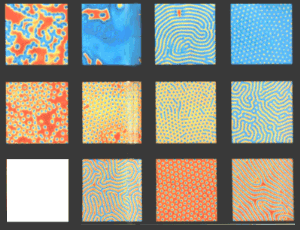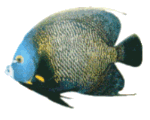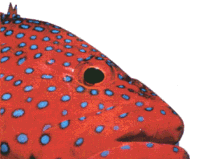
Mathematics |
A NATURAL COMPUTER ART - Computer images (above echo patterns in nature - such as this jaguar skin (below)
We know a leopard can't change its spots, but it turns out that simple chemical reactions can produce spots, stripes, and swirls.
Similar processes may form patterns in leopard skins,snowflakes - even spiral galaxies
Mathematician and computer pioneer Alan Turing first speculated about the causes of such patterns 40 years ago, but committed suicide before his work bore fruit. Now scientists are once again exploring his ideas, with astonishing results.
All of life depends on chemical reactions, from breathing to the complex processes governing the specialisation of cells skin in embryos.
These chemical reactions involve the interaction and spread of proteins throughout the developing baby.
THE DANCE OF THE SPOTS - Self-replicating dots on a computer simulate a chemical "reaction diffusion" system |
These "reaction-diffusion" systems interested Turing who thought they might explain the markings on birds and animals.[Ref: Video:BB14: RI 5]
But John Pearson, a theoretical physicist at Los Alamos National Laboratory in America,has now found evidence that such reactions may explain much more than just the stripes on a zebra.
 |
| NATURAL LAW - Natural Patterns,seen here on an Angelfish have caused scientists to explore the chemical process that nay underlie the markings on birds and animals |
Pearson wrote down the equations that model a simple biological reaction-diffusion system,and used a computer to solve them, creating an electronic chemical reaction. When he displayed the results in colour he discovered, an astonishing range of patterns.
By varying a few of the basic ingredients of the reaction, and the speed at which it took place, Pearson created labyrinths of blue and orange, intertwining and then vanishing; he saw spots form in an evolving chaotic arrangement; and he found an arrangement of four spots in which each spot then divided to form two more, in an echo of the process of cell division.
Professor Harry Swinney at the University of Texas repeated Pearson's experiments using real chemical compounds - and got the same results. To alter the reaction patterns,instead of changing the computer's data values,Swinney added packets of energy with light from an ultraviolet laser.
Through experiments such as these,scientists are coming to believe there is a hitherto unsuspected simplicity underlying the apparently huge diversity in nature.

New idea on how the zebra got its stripes
![]() Jan1994 .
Jan1994 .